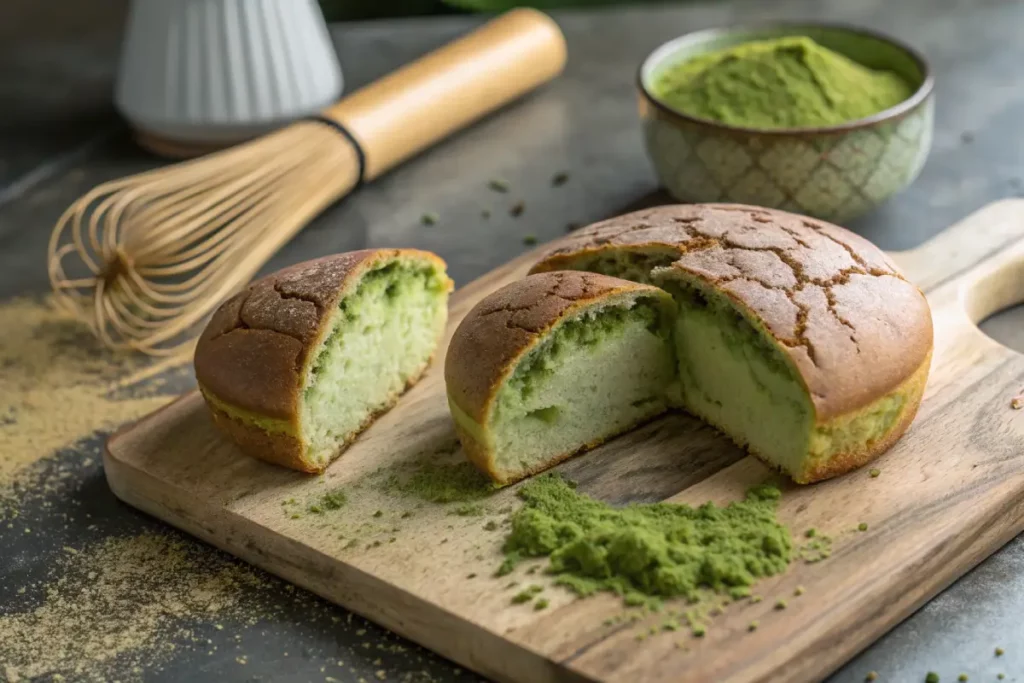Matcha Pan is quickly becoming a favorite in both Asian and Western bakeries. Combining the soft texture of Japanese sweet bread with the earthy richness of matcha, this treat stands out for its unique color and flavor. Whether you’ve seen it on Instagram or tried it at a bakery, Matcha Pan delivers a delicate balance of sweetness and green tea depth. In this article, you’ll learn everything about Matcha Pan—from its roots and ingredients to preparation tips and health facts. Plus, we’ll answer top questions like whether matcha is halal, why it’s pricey, and how heat affects its benefits.
What is Matcha Pan?
Matcha Pan Explained
Matcha Pan is a sweet, fluffy bread infused with matcha, a finely ground powder made from specially grown green tea leaves. In Japanese, “pan” simply means bread. When combined, the term refers to matcha-flavored bread, often baked with fillings such as white bean paste, cream, or chocolate. Its color is unmistakably green, and its taste is lightly bitter, balanced by the natural sweetness of the bread dough.
Unlike other desserts that only include a matcha glaze or dusting, Matcha Pan incorporates the green tea powder into the dough itself. This means every bite carries the smooth umami and grassy tones that matcha fans crave. The bread often has a cracked sugar cookie crust on top, inspired by melon pan, giving it a crunchy outside and soft, airy inside.
The Origin and Meaning Behind Matcha Pan
Matcha Pan is deeply rooted in Japanese baking traditions. While “melon pan” has been around for decades, the introduction of matcha into bread recipes emerged alongside the global rise in matcha popularity. This shift turned a local bakery staple into an international trend.
Bakeries in Japan began crafting matcha versions of classic breads to appeal to both tradition and trend. As Japanese matcha became more accessible worldwide, bakeries outside Japan—especially in the U.S., Canada, and parts of Europe—started offering their own takes on Matcha Pan.
The matcha used in pan recipes is often culinary-grade, chosen for baking rather than ceremonial use. Still, it provides the signature green hue and earthy aroma that make this bread instantly recognizable. As the term continues to spread online, “Matcha Pan” now represents a wide range of green tea-infused bread, both filled and plain.
Why Matcha Pan is Trending
Matcha’s Rise in Western Baking
Over the last decade, matcha has shifted from a niche ingredient to a mainstream flavor in everything from lattes to ice cream. The popularity of matcha-based desserts opened the door for baked goods like Matcha Pan to shine. Western bakeries, cafés, and food bloggers began introducing their own takes on this traditional bread, and the results were an instant hit.
Part of the trend comes from matcha’s visual appeal. The bright green color of Matcha Pan makes it instantly “Instagrammable,” drawing the attention of food lovers across the world. But there’s more to its appeal than looks. The bread offers a satisfying combination of light bitterness from matcha and the sweetness of enriched dough, similar in base texture to Japanese milk bread. Curious about how soft that texture is? You can check out How to Make Japanese Milk Bread for reference—it’s the same style used in many Matcha Pan recipes.
As a result, this bread has carved out its own niche in the baking world, often found in Asian fusion cafés, artisanal bakeries, and weekend farmer’s markets.
Health-Conscious Consumers and the Matcha Craze
Another reason for Matcha Pan’s popularity is the growing interest in wellness and natural ingredients. Consumers are more focused than ever on what goes into their food. Matcha offers a perceived health boost thanks to its antioxidants and calming effects, thanks to L-theanine. When combined with bread made from high-quality ingredients, Matcha Pan feels like a smarter indulgence.
This health-friendly halo makes it appealing to both adventurous eaters and mindful snackers. And unlike sugary donuts or heavy pastries, Matcha Pan provides a lighter taste that feels satisfying without being overly sweet.
Because matcha is tied to focus and calm energy, many view Matcha Pan as a more balanced option—especially during mid-day breaks or tea time.
Key Ingredients in Matcha Pan
Choosing Quality Matcha Powder
The soul of Matcha Pan lies in the quality of the matcha powder used. Not all matcha is created equal, and choosing the wrong kind can lead to dull color, bitter flavor, or weak aroma. For baking, culinary-grade matcha works best. It’s more robust and made for high-temperature applications, unlike ceremonial-grade matcha which is meant for tea ceremonies.
When buying matcha for Matcha Pan, look for bright green powder with a fine texture. Avoid matcha with yellow or brown hues—that often signals it has oxidized or is of lower quality. Premium culinary matcha balances well with enriched bread dough, producing a consistent green shade without overpowering bitterness.
You’ll usually need just one to two tablespoons of matcha per batch, but the difference a good brand makes is noticeable in taste, texture, and aroma.
The Best Flour and Filling Combinations
Matcha Pan dough is typically made with bread flour for its high protein content, giving the bread its signature chew and bounce. Some recipes blend bread flour with cake flour to soften the final texture even more.
When it comes to fillings, white bean paste (shiro-an) is a common and traditional choice. Its mild sweetness pairs beautifully with matcha’s earthy notes. Other variations use sweet cream cheese, custard, or even chocolate. Each filling brings out a new dimension in the Matcha Pan experience.
The sugar cookie crust seen in some versions (inspired by melon pan) adds a crunchy top layer that contrasts with the pillowy inside. Butter, milk, eggs, and sugar round out the enriched dough—so it’s not just green bread, it’s a treat with depth.
If you’re new to baking bread from scratch, take a quick look at 5 Baking Tips for Beginners to avoid common mistakes before starting your Matcha Pan journey.
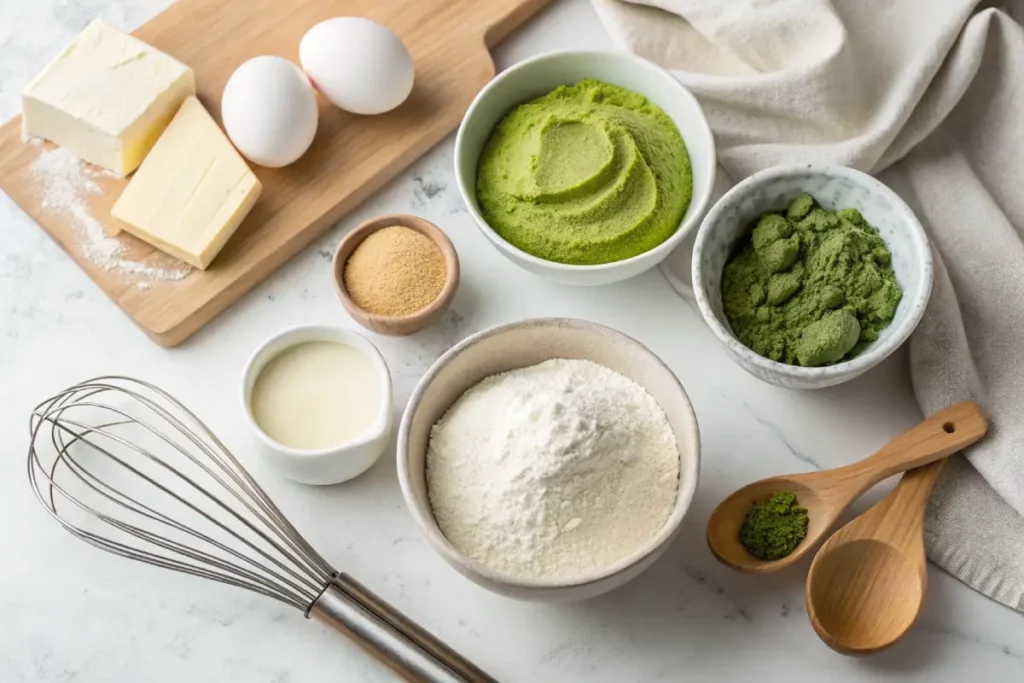
How to Make Matcha Pan at Home
Step-by-Step Process for Baking
Making Matcha Pan at home may sound complex, but it’s absolutely doable with the right approach. Start by preparing a soft, enriched dough using bread flour, sugar, yeast, eggs, butter, and milk. Once the dough comes together and becomes elastic, mix in your matcha powder. The matcha should be sifted to avoid clumps and ensure even distribution.
Let the dough rise until doubled, usually about 60–90 minutes. While waiting, prepare any desired filling—whether it’s white bean paste, custard, or sweetened cream cheese. Once risen, divide the dough, fill each portion, and shape it into balls.
For the top crust (optional but highly recommended), combine flour, sugar, butter, and more matcha. Flatten this mixture into thin rounds and gently press over each dough ball. Let the shaped Matcha Pan proof again for 30–45 minutes, then bake at 340°F (170°C) for 12–15 minutes until lightly golden on the edges and firm on top.
Don’t forget to cool slightly before eating—it helps the flavors settle.
If you like chicken, you’ll want to check out this pineapple teriyaki chicken.
Common Mistakes to Avoid During Preparation
A few key missteps can affect your Matcha Pan results. First, don’t overheat the milk or butter while prepping the dough. Yeast is sensitive, and too much heat can kill it. Always allow your ingredients to come to room temperature before starting.
Second, use the right amount of matcha. Too little and the flavor gets lost; too much and the bread becomes bitter. One to two tablespoons of quality matcha is the sweet spot for most home bakers.
Also, knead the dough long enough to build gluten, but not so long it becomes tough. If your dough tears when stretched, knead a bit more.
Lastly, don’t skip the second proofing step. That extra rise makes the bread fluffy and soft—two things Matcha Pan should always be.
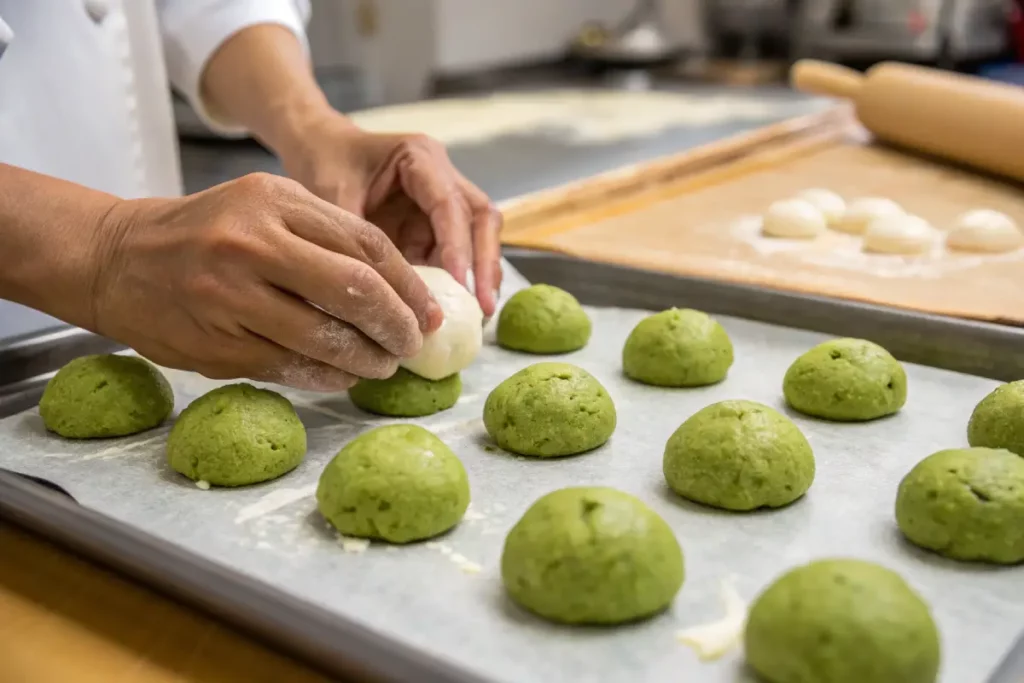
Is Matcha Pan Healthy?
Nutritional Benefits of Matcha
One of the reasons people love Matcha Pan is the belief that it offers some health perks beyond just being a sweet snack. That’s mostly thanks to the matcha powder. Matcha is rich in antioxidants, especially catechins like EGCG, which help fight inflammation and support immune function. It also contains L-theanine, an amino acid that promotes calm energy and focus—unlike the jittery buzz from coffee.
When you include matcha in baked goods like Matcha Pan, you still get some of those health benefits, especially if the bread is made with less sugar or uses whole ingredients. The amount of matcha in each bun may not be enough to drastically change your health, but it adds a meaningful boost compared to traditional sweet breads.
Additionally, if you’re mindful about ingredients—such as choosing organic matcha, reducing sugar, or using whole wheat flour—you can improve the overall nutritional profile of your homemade Matcha Pan.
Is Matcha Pan Good for Daily Consumption?
Enjoying Matcha Pan regularly depends on the recipe and portion size. A traditional Matcha Pan made with white flour, butter, and sugar is still a treat—something to enjoy in moderation. But if you bake it yourself, you have control over what goes in. Reducing sugar, using plant-based milk, or adding fiber-rich flours are ways to enjoy this bread more frequently.
The matcha itself is perfectly fine to consume daily in small amounts. However, balance is key. Too much matcha can lead to caffeine overload or digestive discomfort for sensitive individuals.
In general, when made thoughtfully, Matcha Pan can fit into a balanced diet. It offers flavor, color, and a touch of antioxidants, all wrapped in a satisfying bite of soft bread.
Matcha and Heat: Does It Lose Its Benefits?
How Heat Affects Matcha’s Antioxidants
Many people wonder if baking with matcha affects its health benefits. The answer is yes—some antioxidant content can be reduced when matcha is exposed to high temperatures. EGCG, the most powerful catechin in matcha, is heat-sensitive. That means baking Matcha Pan at high temperatures for long periods can decrease its antioxidant strength.
But not all the good stuff disappears. Matcha still retains a portion of its beneficial compounds, including L-theanine and other polyphenols, even after baking. The key is in how you bake it. Lower baking temperatures for shorter times help preserve more of matcha’s healthful qualities.
If you’re focused on maximizing benefits while making Matcha Pan, be mindful of oven temperature and avoid overbaking.
Best Baking Temperatures for Matcha
To retain matcha’s color and properties in Matcha Pan, keep your baking temperature between 325°F and 350°F (160°C to 175°C). Higher heat may dull the green color, turning it brownish and affecting flavor. Using quality matcha powder also makes a huge difference—it stays vibrant and aromatic even after baking.
Check out Our frozen salmon in air fryer.
Keeping the oven slightly lower than typical baking recipes can go a long way in preserving both the flavor and the nutritional edge that matcha brings.
FAQs About Matcha Pan
Is Matcha Halal?
Yes, matcha itself is halal. It’s made from finely ground green tea leaves without any animal-derived ingredients, alcohol, or impurities that would make it questionable. When it comes to Matcha Pan, though, it depends on the additional ingredients used in the recipe. For example, some fillings may include gelatin or flavorings that aren’t halal-certified. The dough might contain emulsifiers or dairy sourced from non-halal providers in commercial bakeries.
Why is Matcha So Expensive?
Matcha isn’t your average green tea. Its high cost comes from the way it’s grown, harvested, and processed. The plants are shade-grown for weeks before harvest to increase chlorophyll and amino acids, giving matcha its vibrant green color and umami flavor. Then, only the youngest leaves are picked, steamed, dried, and stone-ground into a fine powder. This labor-intensive method results in a concentrated form of tea with a strong flavor and aroma.
Is matcha good or bad for your health?
Matcha is generally good for your health. It’s rich in antioxidants like EGCG, supports metabolism, and promotes calm alertness due to its combination of caffeine and L-theanine. In Matcha Pan, some of these benefits remain, though it’s still a sweet bread—so moderation is key.
Does heat destroy matcha?
High heat can reduce some of matcha’s antioxidant properties, especially EGCG. However, baking at moderate temperatures, as with Matcha Pan, still retains a good portion of its health compounds. Using quality matcha and not overbaking helps preserve both nutrients and flavor.
Where to Buy or Enjoy Matcha Pan
Best Places to Find Authentic Matcha Pan
Matcha Pan has grown beyond niche bakeries. Today, you can find it in Asian supermarkets, Japanese-style bakeries, and trendy cafés in major cities. Stores like Mitsuwa, H Mart, and 85°C Bakery Café often carry fresh Matcha Pan with different fillings.
If you live in an area with a local Asian bakery, there’s a good chance they’ll have Matcha Pan as part of their regular rotation. It’s also becoming more common at farmers’ markets and pop-up pastry shops in urban food scenes. Authentic versions usually feature a sugar cookie crust on top, a soft center, and deep green dough made with high-quality matcha.
Look for places that use real matcha powder and avoid artificial flavoring—those are signs you’re getting the real deal.
Online Stores vs. Local Bakeries
If you can’t find Matcha Pan locally, don’t worry—many bakeries now ship nationwide. Online platforms like Goldbelly or specific Japanese bakeries offer shipping within the U.S. You can also find DIY baking kits for Matcha Pan, which come with pre-measured ingredients and instructions.
That said, nothing beats the experience of visiting a bakery in person. Freshly baked Matcha Pan has a texture and aroma that’s hard to replicate after shipping. You can also ask staff about ingredients and watch for seasonal variations like matcha-strawberry or matcha-chocolate buns.
Serving Suggestions for Matcha Pan
Best Ways to Enjoy Matcha Pan
Matcha Pan is incredibly versatile—enjoy it as a snack, part of a brunch spread, or with afternoon tea. Serve it slightly warm so the soft center and filling are at their best. If your Matcha Pan has a cookie crust, warming it for a few seconds in the oven brings back the crisp texture without overbaking.
Pair your bun with a matcha latte, black coffee, or a glass of milk. The earthy tones from the matcha complement both bold and creamy beverages.
If you’re hosting a gathering, consider serving Matcha Pan on a platter with fresh fruit, whipped cream, or a dusting of powdered sugar for an elegant twist. This bread’s vibrant green color makes it a standout on any dessert table.
How to Store and Reheat Matcha Pan
Store Matcha Pan in an airtight container at room temperature for up to 2 days. If you’d like to keep it longer, you can refrigerate it for 4–5 days or freeze for up to one month.
To reheat, place the buns in a preheated 300°F (150°C) oven for about 5 minutes or microwave for 10–15 seconds. Avoid overheating, as this can dry out the bread or dull the matcha flavor.
If you’ve added a cookie crust topping, reheating in the oven is preferred—it revives the crispy texture without compromising the bread’s fluffiness.
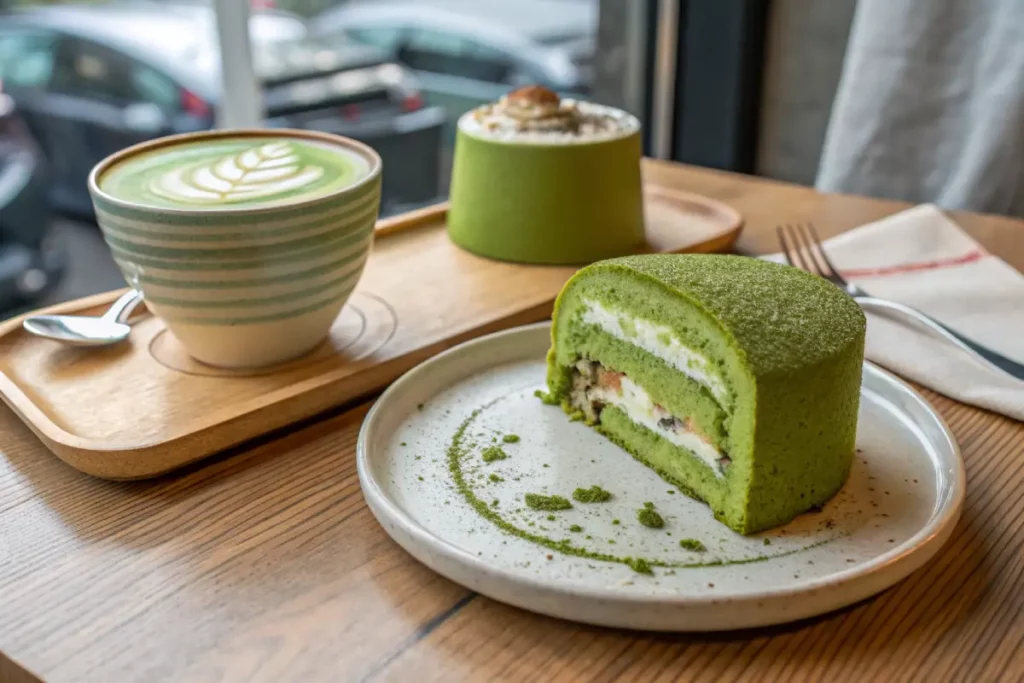
Conclusion
Matcha Pan is more than just a pretty green bread—it’s a soft, flavorful treat that brings together the delicate bitterness of matcha with the comfort of sweet, fluffy dough. Whether you’re baking it at home or picking one up from your favorite local bakery, Matcha Pan delivers a balance of taste, texture, and nutrition that makes it hard to resist.
With rising interest in health-friendly ingredients and Japanese-inspired desserts, Matcha Pan continues to earn its spot as a go-to snack for both foodies and casual eaters. From the importance of using quality matcha to understanding how heat affects its benefits, you now have all the facts to enjoy this treat more fully.
And remember, when made with simple, wholesome ingredients, Matcha Pan can be part of a balanced diet—and a delicious one at that.
Print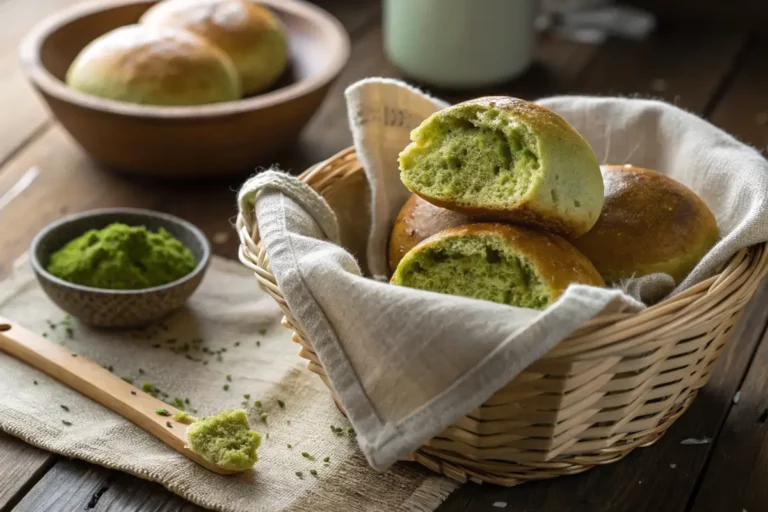
Matcha Pan Recipe: Soft, Fluffy Bread with a Unique Green Twist
Soft, fluffy, and packed with earthy flavor, this Matcha Pan recipe combines traditional Japanese baking with a modern green tea twist. Perfect for breakfast, snack time, or tea pairing.
- Total Time: 1 hour 45 minutes
- Yield: 8 buns 1x
Ingredients
2 cups bread flour
2 tbsp matcha powder (culinary grade)
2 tbsp sugar
1/2 tsp salt
2 tsp instant yeast
1/2 cup warm milk
1 egg
2 tbsp unsalted butter, softened
Filling of choice (white bean paste, cream cheese, or chocolate)
Optional: Cookie crust topping (1/2 cup flour, 2 tbsp butter, 2 tbsp sugar, 1 tsp matcha)
Instructions
1. Combine flour, sugar, salt, matcha powder, and yeast in a large bowl.
2. Add warm milk and egg, then mix until a shaggy dough forms.
3. Knead in softened butter until smooth and elastic.
4. Cover and let rise for 1 hour or until doubled in size.
5. Punch down the dough and divide into equal balls.
6. Flatten each, add filling in center, and shape into sealed buns.
7. Optional: Prepare cookie crust, flatten, and place over each bun.
8. Let rise again for 30–45 minutes.
9. Preheat oven to 340°F (170°C).
10. Bake for 12–15 minutes or until edges are golden.
11. Cool slightly and serve warm or at room temperature.
Notes
Store in an airtight container at room temperature for up to 2 days.
For best color and flavor, use high-quality matcha powder.
Buns freeze well; reheat in oven or microwave.
- Prep Time: 90 minutes
- Cook Time: 15 minutes
- Category: Bread, Dessert
- Method: Baking
- Cuisine: Japanese
Nutrition
- Serving Size: 1 bun
- Calories: 210
- Sugar: 8g
- Sodium: 160mg
- Fat: 7g
- Saturated Fat: 4g
- Unsaturated Fat: 3g
- Trans Fat: 0g
- Carbohydrates: 30g
- Fiber: 2g
- Protein: 5g
Keywords: matcha pan, matcha bread, japanese sweet bread
